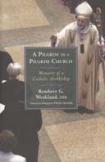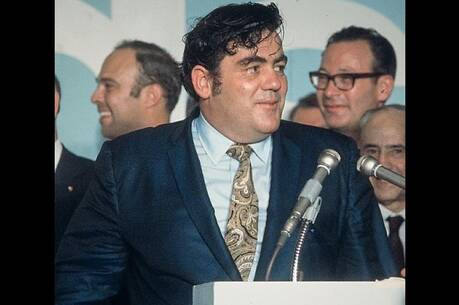The Bishop's Tale
The English mystery writer P. D. James once said she would not review a book written by a friend. I thought that was good advice when I read it, but now I am about to ignore it.
I have known Archbishop Rembert Weakland for over 30 years. He wrote the preface to my first book, which was about the Rule of St. Benedict in family life. I have his picture in my office nestled in among photos of family and other friends. (He is seated at a piano engrossed in a Chopin waltz.) When I worked at the U.S. Conference of Catholic Bishops we collaborated on a number of issues and projects. I respected his erudition and intellectual prowess, and we shared a love for Benedictine traditions.
So when I heard the radio report on May 23, 2002, that he had had an affair with a man decades earlier, and that in 1998 there had been a cash settlement of $450,000, two thoughts converged: one, that he fell in love, probably for the first time, and that falling in love has a way of humanizing us; two, that nobody in church leadership—bishop, cardinal, whoever—should have free access to large sums of money. I knew that canon law allows bishops to avail themselves of church funds if the amount is not $500,000 or more, and to do so without the involvement of the diocesan finance committee. But less ($450,000 in the Weakland case) does not require oversight. This distinction, while legal in the strict sense of church law, seemed to me to fail a basic ethical test, as normal people understand ethics. I thought at the time that canon law needs some fixing; I still think so.
So with these “disclosures” and concerns as background, I entered into the memoir of an American archbishop.
The author begins with his personal crisis: the revelation of his long ago sexual affair and the payment of settlement money. In sorrow and humility, he makes a public confession of his transgressions in the context of a penitential service displaying not only an innate sense of drama but also an appreciation of history. One is reminded of penance in the early centuries of the church, when certain sins, confessed in public, earned the penitent a pilgrimage, often to dangerous places.
Weakland, indeed, goes on pilgrimage in the pages of this memoir, and the reader goes with him. After his public confession, he returns, using Chaucer’s Canterbury Tales as a map of sorts, to the places of origin that shaped him at various stages of his life’s journey. The family home in Paton, Pa., where his widowed mother raised six children, one of whom, George (later Rembert), displayed a gift for music; and St. Vincent Archabbey in Latrobe, Pa., where as a young teenager he began his lifelong explorations into the life of the mind.
The Benedictines gave the young Weakland the best education possible, not only in their own school, but later at the Julliard School of Music in New York and Columbia University, where he studied medieval literature, art and architecture. Columbia granted him a scholarship that allowed him to study in Milan, where he first met the archbishop of Milan, Giovanni Montini, later Pope Paul VI. That was the beginning of one of the most important relationships in Weakland’s life.
With every experience, his world—including the church world—grew larger and culturally richer. But the Benedictines gave him something more, something that remains to this day. They gave him the Rule of Benedict as a way to center his life and to guide him as he moved from one leadership role to another, nationally and internationally. He learned from the monks who were involved in his formation that St. Benedict saw the monk as one on a search for God. Benedict did not say the important point was finding God, but the continuous search for God. In all of the roles and responsibilities that were his over the years—abbot of St. Vincent’s, abbot primate of all the Benedictine houses in the world, archbishop of Milwaukee, a national leader regarding issues of social justice, liturgy, ecumenical and interreligious matters—always the Rule, the Benedictine way of life, anchored him.
As I read A Pilgrim in a Pilgrim Church, I was reminded of three of my favorite memoirists. Like the Polish writer Czeslaw Milosz, Weakland places the self against a historical background. He demonstrates that the personal and the historical can illuminate each other, and bring history from the realm of the abstract to that of the concrete through the medium of the personal story. We meet the ecclesiastical structure of the Catholic Church through his encounters with real people, and history comes alive.
Patricia Hampl does something similar. She is skilled in relating the personal story to a larger horizon. For her, the memoir is an effort to learn things one could not otherwise know; it is a movement toward talking about big issues, including meaning and values. Weakland’s story does this too. With its triumphs and failures, its sorrow and shame, this monk’s tale not only moves him to a deeper level of self-understanding but raises big issues the church needs to grapple with honestly: the role of the laity in the contemporary church, and especially of women; the failure to prepare celibate leaders to deal with human/sexual development; the theological contradictions in the claim that homosexual orientation is intrinsically disordered; the meaning of authority in the light of the Gospel; the structural reasons behind the bishops’ incompetence in the sexual abuse crises; and the uses and misuses of money. And that’s the short list.
Finally, I thought of Euginia Ginzburg, who wrote about her life as a political prisoner in Stalin’s Siberian camps. She assured her readers that she had written down the truth, not the whole truth, she said, because she had neither the range of information nor the skill and because no one knows the whole truth. But she insisted there were no lies in her account. I believe there are no lies in Weakland’s pilgrimage account. He speaks the truth, a deeply personal truth. Are there suppressions? Probably. We all carry unconscious suppressions. Might his judgments be skewed? Perhaps. Who of us is free of bias? But I can find no deliberate deception in these pages.
A Pilgrim in a Pilgrim Church becomes a lens for viewing—and understanding a little better—a period of church history where tensions, confusion and hope intertwined.
This article also appeared in print, under the headline “The Bishop's Tale,” in the October 5, 2009, issue.








